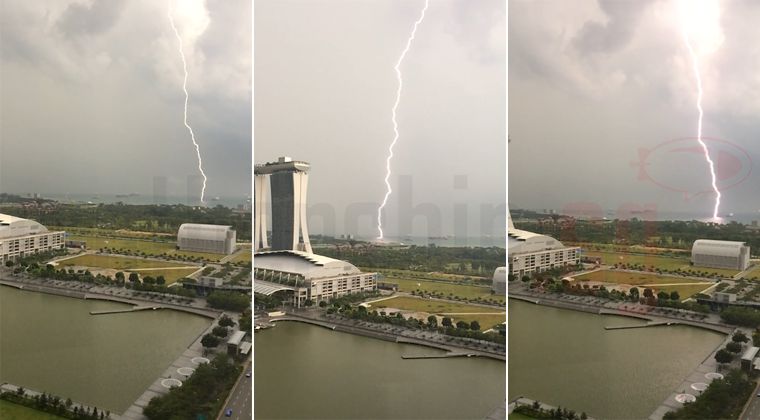Singapore has anywhere between 171 and 186 lightning days on average a year. Each square kilometer of land in Singapore can be struck up to 16 times annually.
April, May and November are the most lightning-prone months as a result of the intense inter-monsoon conditions.
This makes us effectively one of the lightning capitals of the world.
This following gorgeous photo of lightning in Singapore by photographer Darren Soh, put up on Facebook on May 22, 2016, shows the intense lightning activity during that month of torrential rain:
It is an image layered with 12 photos shot just under a one-hour period to capture the number of big lightning strikes.
Here is another set of photos showing the extend and frequency of lightning strikes all over Singapore:
Lightning strikes and the damage caused
How frequent and damaging are lightning strikes in Singapore?
More often than not, they are not potent or fatal as Singapore is generally well-protected from lightning.
The top photo seen above, for example, is of multiple big lightning strikes hitting the waters off Marina Bay Sands in the space of several minutes that was taken a few years ago. Apart from a few dead fishes on the surface, water bodies are effective in dispersing the electric current in all directions.
But, on average, there are 0.35 lightning deaths per million people each year in Singapore. This is in comparison to 0.2 in Britain and 0.6 in the United States.
An average lightning strike carries a current of up to 200,000 amps. In comparison, a 100-watt bulb carries a current of about 0.4 amp.
Which explains why wearing rubber shoes as a form of lightning-protection insulation might be a myth as it would not even help when the current is so strong.
Recently, a lightning strike during a heavy thunderstorm was suspected to have crippled an SMRT train on May 11, 2016, which resulted in a bit of an inconvenience for commuters.
The last time fatal lightning strikes made the news was several years ago.
In 2008, a couple was struck by lightning off Punggol jetty in the afternoon. Both appeared to have survived.
In 2011, one man was not so lucky as he was killed and his companion injured after lightning struck them while canoeing in the afternoon at Pasir Ris Park.
As Singapore is exposed to the elements and inclement weather all year round, we enforce very stringent codes for lightning protection. Most public places in Singapore are protected.
For example, devices are fitted to the top of floodlight towers at stadiums, while public pools are equipped with lightning rods.
Buildings, observation towers and other structures meant to house people are also shielded from lightning by law. Gazebos in parks, for example, have metal roofs and are "earthed" with thick metal strips to make them lightning-proof.
But when lightning does strike, it can be safely ignored, as in this case, where the Singapore Flyer was hit by lightning:
" frameborder="0" allowfullscreen>
[related_story]
And if there is damage done to public property, it is more of an inconvenience.
For example, in 2009, the Merlion statue in Marina Bay was hit sometime between 4pm and 5pm. There were no reported injuries but the lightning strike created a hole the size of the football and required the attraction to be closed for a few days for repair work to be carried out.
Live information about lightning and rain activity over Singapore is available at the Meteorological Service Singapore website.
If you like what you read, follow us on Facebook, Instagram, Twitter and Telegram to get the latest updates.
